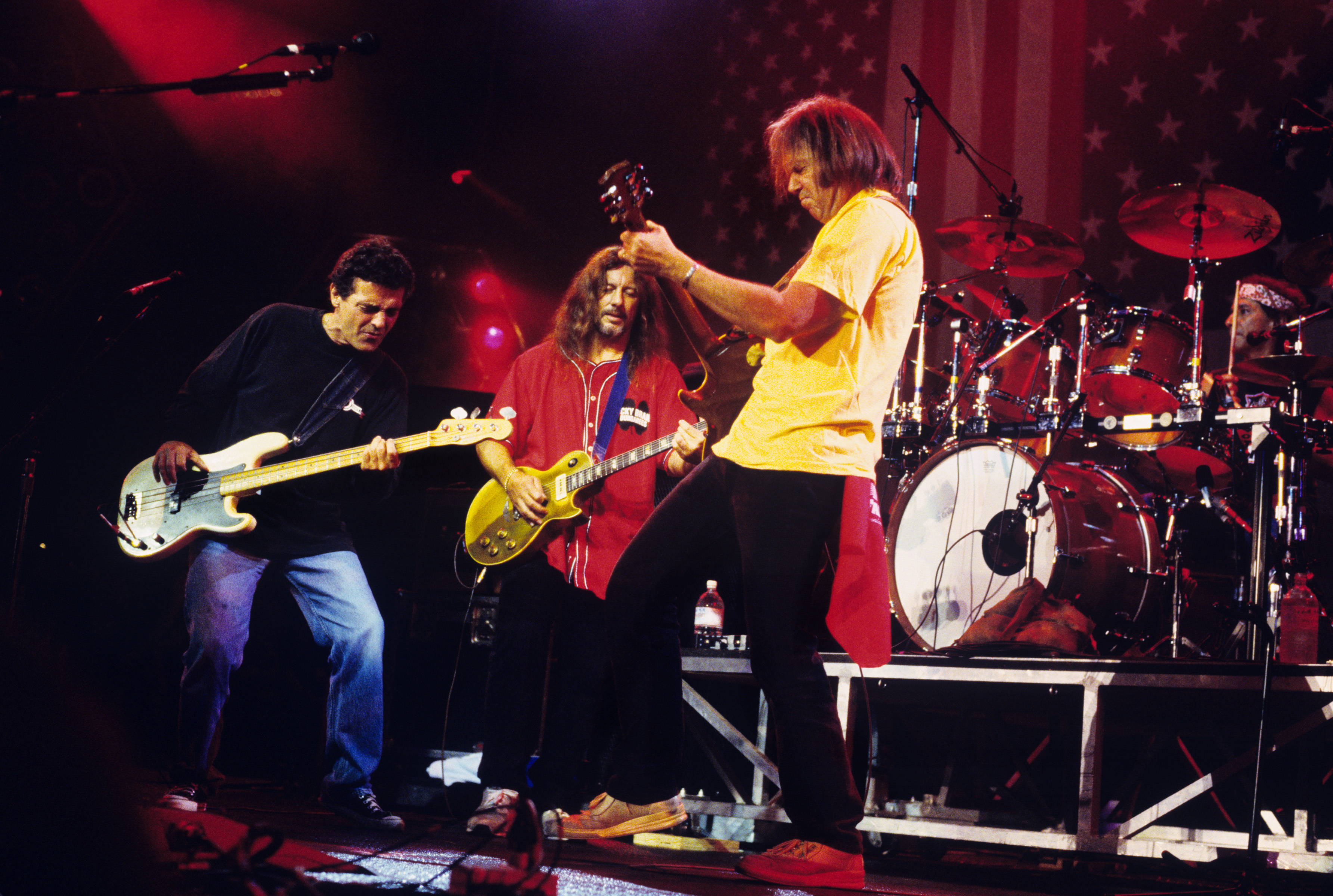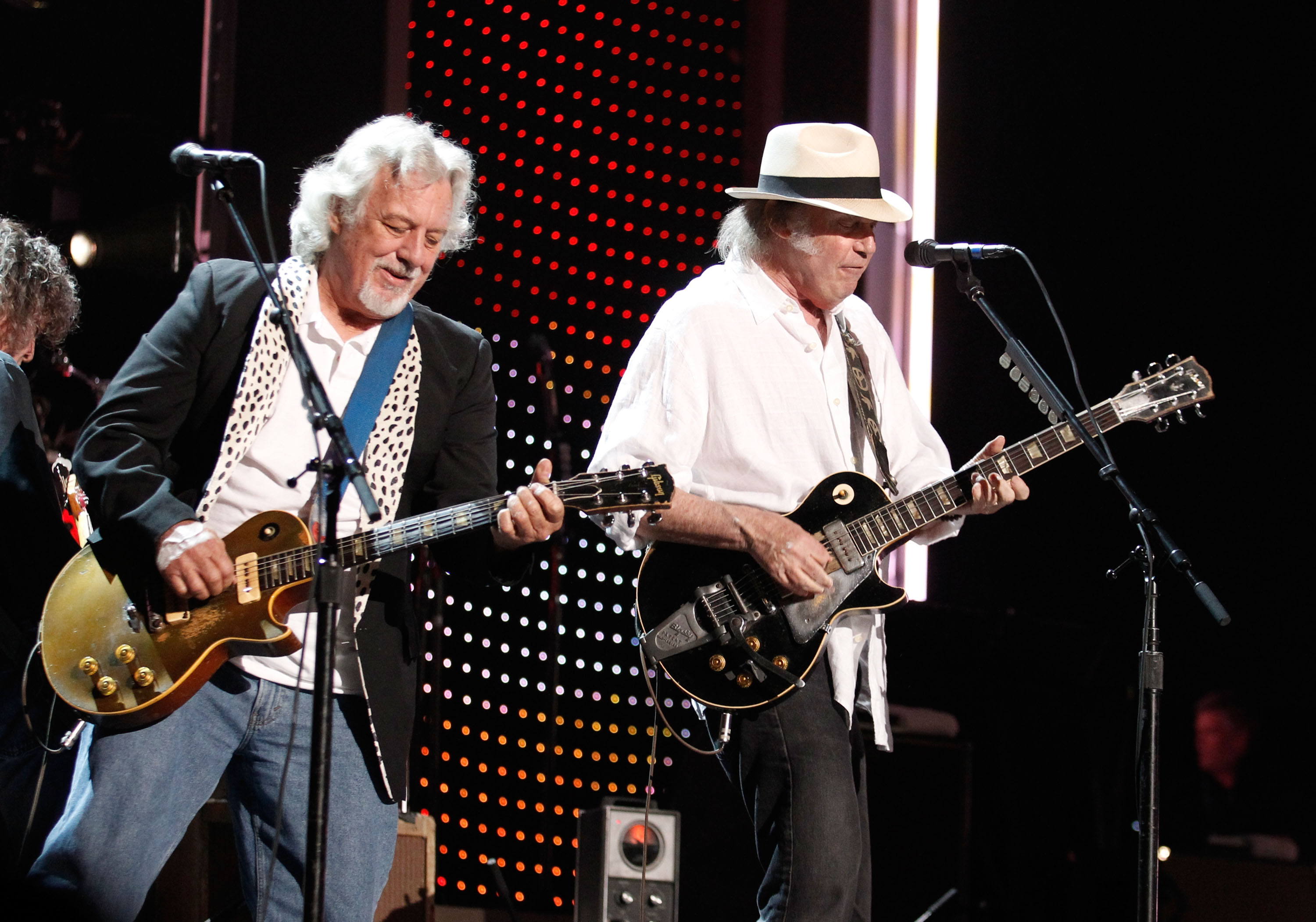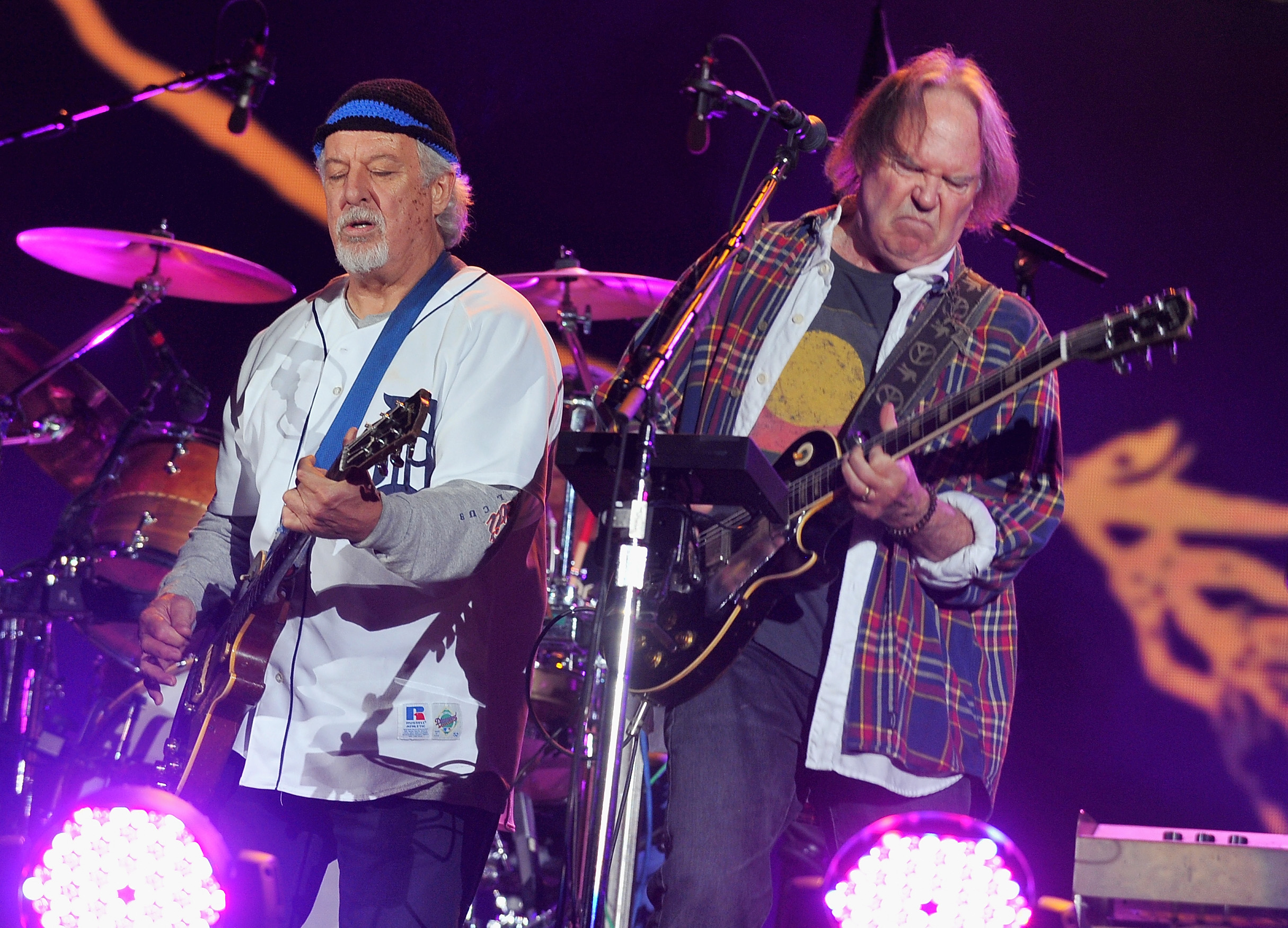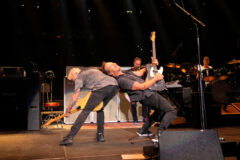By the time 1990 hit, Neil Young and Crazy Horse were in the midst of a resurgence, even if they didn’t realize it at the time. On the heels of the success of 1989’s Freedom, which introduced Young to a younger, harder rockin’ crowd with “Rockin’ in the Free World,” he once again joined forces with the mighty Crazy Horse to kick off the 1990s in style. In this case, the style was a heavier, harder sound.
Frank “Poncho” Sampedro had been playing guitar with Young since the mid-’70s, but he knew when it came time to record and play what would become Ragged Glory that they were onto something. So much so that when the group played the first shows of that album cycle in November 1990 at the Catalyst Club in Santa Cruz, Sampedro can still marvel at the raw intensity and power of that performance.
By the end of the 21-song, three-encore set, where 800 fans were let and thousands were in the neighboring bars partying and rocking along, the band was saluted by fans throwing joints on the stage. The gig happens to be one of the group’s most memorable.
Now retired due to an ongoing battle with arthritis in his wrists, not to mention a torrid case of COVID last year, Sampedro is happy at home on the Big Island of Hawaii, where he dug into Waydown in the Rust Bucket, the latest discovery in the Neil Young archive that chronicled that night in 1990 and was “blown away by it.”
“I really think this is the best Crazy Horse record we ever made,” he says incredulously. “You know, we’re so relaxed at the same time and it’s Neil is so intense and his guitar playing is over the moon. And Ralph plays really great. It’s just wow, it blew my mind.”
Speaking of from his home, Sampedro filled SPIN in on what made that night so memorable, why the subsequent tour with Sonic Youth and Social Distortion so enjoyable, and if he’d ever consider hopping back on the road for one final show.
SPIN: Was there something heading up to those shows in Santa Cruz that made you all want to capture it? Everyone sounds like they’re at the top of their collective games.
Frank “Poncho” Sampedro: Quite honestly, I didn’t even know they ever found [the tapes] until two or three weeks ago. Really, I had no clue. I never heard the bootlegs. That was just a product of Larry Johnson wanting to do it and Neil gave in and let him do it. That’s our home turf and a big weed-growing community. What better place to start the tour — and this wasn’t a warm-up show — than there? It wasn’t about preparing for anything in the future. It was about going out and having a good time. I watched the video and it amazes me. It seems like I was mesmerized by [bassist] Billy [Talbot]. He’s over the moon having so much fun prancing around, singing, playing. I was just looking at him going wild. And he even turned into our emcee that night. It was amazing. I’d never seen him do that.
It’s funny you say that it wasn’t a warm-up show, but rather one that kicked off the tour. That said, before you hit the road in 1991, did you perform together like that anywhere else?
I don’t know whose brilliant plan this was, but we spent two weeks at Paisley Park Studios rehearsing with all of the lights, the sound and the crew. But it was January in Minneapolis. It was frozen there, man! It was so crazy.
Did you all see Prince at all while there?
No, but I did shoot hoops on his basketball court.
But he didn’t pop up at all?
Nah. I don’t think Neil saw him either.
As for the Ragged Glory tour, it was certainly a heavyweight tour in terms of the sound, the tenacity of the dates and the bill itself. Having Sonic Youth and Social Distortion seemed liked it ushered in a new era for you all.
I loved hanging with Social D and Mike [Ness]. Mike is a great guy, and we have so much fun! And Thurston [Moore], he should be like a music historian or a librarian or something. He can compare every song and every group and every era, it’s just amazing. It was a blast.
Looking back at the Catalyst show, was that the only one from that tour that really stuck as being a classic for you all?
The first couple of weeks of the tour, I came fresh out of an emergency appendectomy surgery on Christmas Day [1990] so I wasn’t feeling that great. It ended up being a grueling tour. We weren’t supposed to have more than three shows in a row. Then we’d have three, then drive 16 hours the next gig on our day off to do three more. So to be honest with you, I can’t remember, but the ones I do, like Buffalo, we really stormed Buffalo. The same with New York City and Philadelphia.

What do you remember getting off stage that night, if you remember anything at all?
It was filled with joy. But not only that, all our buddies were there. It wasn’t like walking out to the tour bus and going down the road. We went to the bar we hung out with all our friends. Wasn’t nobody was asking for autographs or any crazy stuff. We were just having a good time. Then a guy asked us if we went outside and we said no. Since there were big glass windows, you can hear we’re playing loud and for more than a few feet. Every place [in that stretch] is packed with people outside partying. So we had a block party we didn’t even know.
At the time of Ragged Glory, what was becoming “popular” rock music began to shift. That’s why the whole “Godfather of Grunge” moniker has stuck with the album. But was Neil aware of what was going on at the time in that regard?
I’ll tell you the truth. Luckily Neil had all the songs when we got up there so we played them for a couple of days by ourselves. [Producer David] Briggs then showed up with this guy John Hanlon and we weren’t really recording yet. Hanlon was a new guy, which freaked us all out. We couldn’t play the next day and it’s where Briggs came up with the phrase “I guess we spooked the Horse.” But after that, we played the songs, the whole set, all the songs every day, three times, five days a week for a month and no one was allowed to listen to the playback. After the fourth week, Neil put it on me to call out the songs. I just started calling them on different orders every day and in the fourth week, I was getting confused. I didn’t enjoy the pressure but I did say [to Neil] “Why don’t we just play a song from your first band. Let’s just play something simple and have a bunch of fun.” And he started “Farmer John.” Briggs wanted it to be edgy and tough, and down and dirty. After he said that, I just started laughing and thinking it was a party. Then he got in Neil’s face and got in my face. He backed us all up against the wall. He read us the riot act about “What do you know? What’s wrong with you guys?” When you see him say that to Neil and the rest of us, [you] don’t think the next take is going to come out like fire? He was the master motivator.

Are there any more archival tapes from this era that you want to hear?
I’d be really interested in hearing the Princeton Landing shows. I don’t know if they have all of those tapes. I was working at the Tonight Show at the time. I would dip out of The Tonight Show like an hour early, catch a plane from Burbank, fly to San Francisco and drive down to Princeton Landing, do three, four or five sets at night and drive back to the San Francisco Airport, stay at the hotel in the airport then get up the next morning, catch a plane, go back to work at NBC. And I did that for weeks. During those shows, I learned a lot about each song. It was way smaller than the Catalyst. There were a lot of people there, but it wasn’t overly packed. And we, you know, we got to explore the songs. It’d be interesting for me to hear those.
Could you ever see yourself getting back and playing with Crazy Horse for one final run? Do you think you could pull it off with your wrists in the condition they’re in right now?
I want to go on the road more than people want me to. When you get called out for messing up a show, you feel bad. At the end of the Alchemy tour, I was rolling down the road with both my hands and ice buckets and one foot in an ice bucket after every show and I was in pain. Then I got my fingers smashed [in a car], and I did the make-up tour for that. There were basically was so many signs to me pointing in my head. I wanted to play, but I knew I was hurting. And then finally when I got home, more than a year later, I figured out it was my arthritis. It was messing up everything. I was firing roadies. I never thought my guitar was in tune at the beginning of every show. It was all in my hands. Then I’m sitting here at home I realized, like wow. After the third, fourth, fifth song, my guitar was always in tune and I played my ass off and nothing was wrong. You know, why was the guitar so good? I was blaming everything on everybody and everything but me. And I was the problem. It’s just it’s a sad thing, but it’s just what it is, man. It’s just what it is. But there are some nights where I wake up in the middle of the night and my left wrist has a sharp pain going up all the way through my fingertips and forearm and I can’t sleep. So should I really try? I don’t know. I would hate to disappoint everybody. I hate to disappoint myself.
Not even for one final hurrah? It’s not like you were messed up and making mistakes on purpose.
No, no. Neil knows why, that’s why you never hear him blabbing [about] any medical condition I have. He understands and he let it go. In a giant fantasy world, one giant show broadcasted around the world, let’s do it. Then you get to management and it’s expensive to do all of that for one show so it’s just not worth it.
Or a reunion at the Catalyst Club, why not? A nice farewell stint could be cool there. Another block party…
[Laughs.] You just said a word that is taboo in Neil Young-land: farewell. He does not believe in farewell. As he’s said in some of his interviews he wants to work until the last day, there’s no farewell. There’s no goodbyes. He’s not Cher.
But that’s what pushed you guys as far as it has.
It’s always a blast when we all get together. I was so excited that the last record, [2012’s] Psychedelic Pill that “Drifting Back” was on it because was the first time we jammed in like eight years or nine years and it caught it all on tape. We played this whole 20-something-minute song and that’s because we were excited to play. It’s not great all the time. At that point, we were just having a good time and to me, that’s one of the gems of all our recordings because it just captures who we are at the moment in a really special moment.





